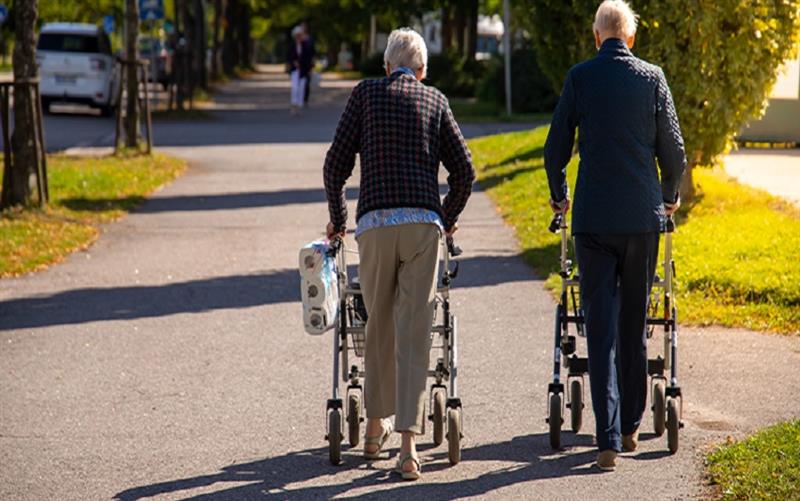
Mobility tools offer a great service. They enable people to keep some of their independence. Rollators and walkers are two common mobility aids that can be quite beneficial.
The term "wheeled walker" is sometimes used to describe a rollator, which differs from a 2-wheeled walker. It is made up of a frame with three or four substantial wheels, handlebars, and an integrated seat. Patients who simply require a walker for balance and not for weight-bearing typically utilize it.
A rollator might be a better option for you if your health condition necessitates frequent rest stops. A rollator with a seat and a crossbar for back support allows the user to stop and take a break as needed, unlike a walker that has no seat.
Here's what makes a rollator unique: Key features of rollator
1. Wheels and Mobility:
One of the key differences is the presence of wheels on a rollator. Unlike a walker, which typically has four legs without wheels, a rollator is equipped with wheels on all four legs. This design allows the user to move forward with greater ease and requires less effort, making it particularly beneficial for those who have limited strength or stamina.
2. Braking System:
Rollators come with a built-in braking system that allows the user to control their speed and come to a complete stop when needed. This provides a sense of security and stability, especially when navigating inclines or uneven surfaces. Walkers, on the other hand, do not usually have this braking mechanism.
3. Seat and Backrest:
Many rollators feature a padded seat and a backrest, which can be folded up when not in use. This additional feature offers the user a convenient place to rest when they need to take a break. Walkers generally lack this built-in seating option.
4. Storage and Accessories:
Rollators often come with storage options such as baskets or pouches attached to the frame. Users can carry personal items, groceries, or medical supplies conveniently while using the rollator. Walkers typically do not have such storage capabilities.
5. Maneuverability:
Due to the wheels and swivel casters on a rollator, it offers greater maneuverability and ease of turning compared to a walker. This makes it suitable for indoor and outdoor use, as well as negotiating tight spaces.
6. Foldability:
Rollators are designed to be foldable, which facilitates storage and transportation. They can be collapsed and stored in a compact form, making them more versatile for travel or storage when not in use. While some walkers can be folded, not all models have this feature.
7. Weight Capacity:
Rollators are generally designed to support a higher weight capacity compared to traditional walkers. This added strength can be crucial for users who require extra support.
Different type of Rollators
Rollators come in a variety of designs to suit various requirements.Many functions that are available for rollators are not unique, just like ones for walkers. A rollator with height-adjustable handlebars, a seat that can be raised or lowered, and hand brakes is an option.
1. Height-Adjustable Rollator
The seat and handlebars of a rollator may be height-adjustable. Some of them are versatile enough to be marketed as both "youth" and "adult" models.
2. Control brakes
Rollators, whether they have three or four wheels, have wheels on every leg, unlike walkers. Rollators have handle brakes as a result.
3. Rollator Weight Norm
A rollator typically weighs roughly 15 pounds.
There are certain models that claim to be "lightweight." These small models might weigh as little as eleven pounds. Some people see a difference after losing a few pounds.
The other thing to think about when it comes to weight is "weight-capacity." The safety of standard rollators has been tested for users weighing up to 250–350 pounds.
4. Rollator that folds
Rollators may have a function that makes it simple for them to fold up, just like walkers do. They are simpler to fit into a car, bus, or airplane when they are flat.
5. Rollator Indoor/Outdoor
Do you often go out? There are rollators available with non-marring tires that are typically at least 6" in diameter and soft-grip casters. These serve a dual role by facilitating movement over park dirt paths while protecting your home flooring from damage. For rough terrain and outdoor use, larger wheels (8" and 10") are preferable.
6. Rollator with three wheels
The tricycle-like rollator has three wheels. It is lighter than the majority of four-wheel vehicles, and some claim that because the three wheels allow for sharper bends, they are easier to operate.
This is particularly useful in cramped areas. These devices may also include a simple folding mechanism to make transit easier. However, these typically lack an integrated seat.